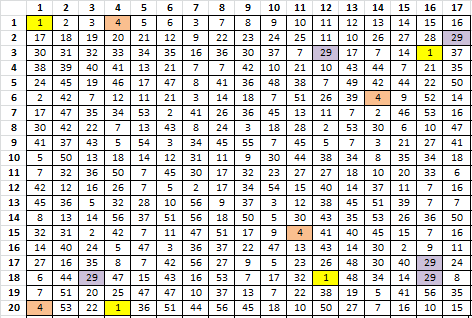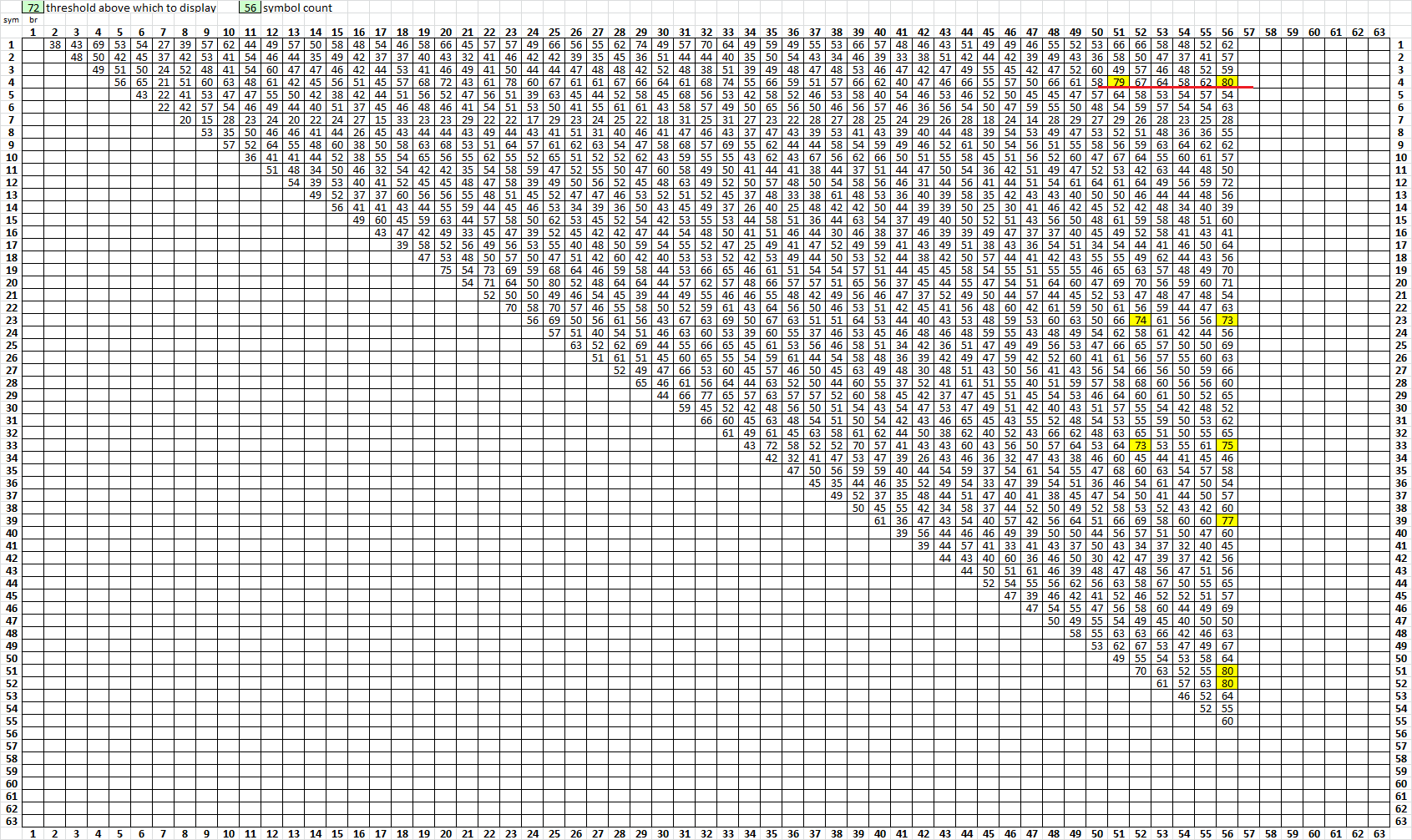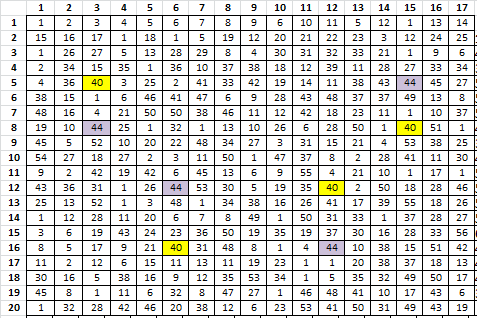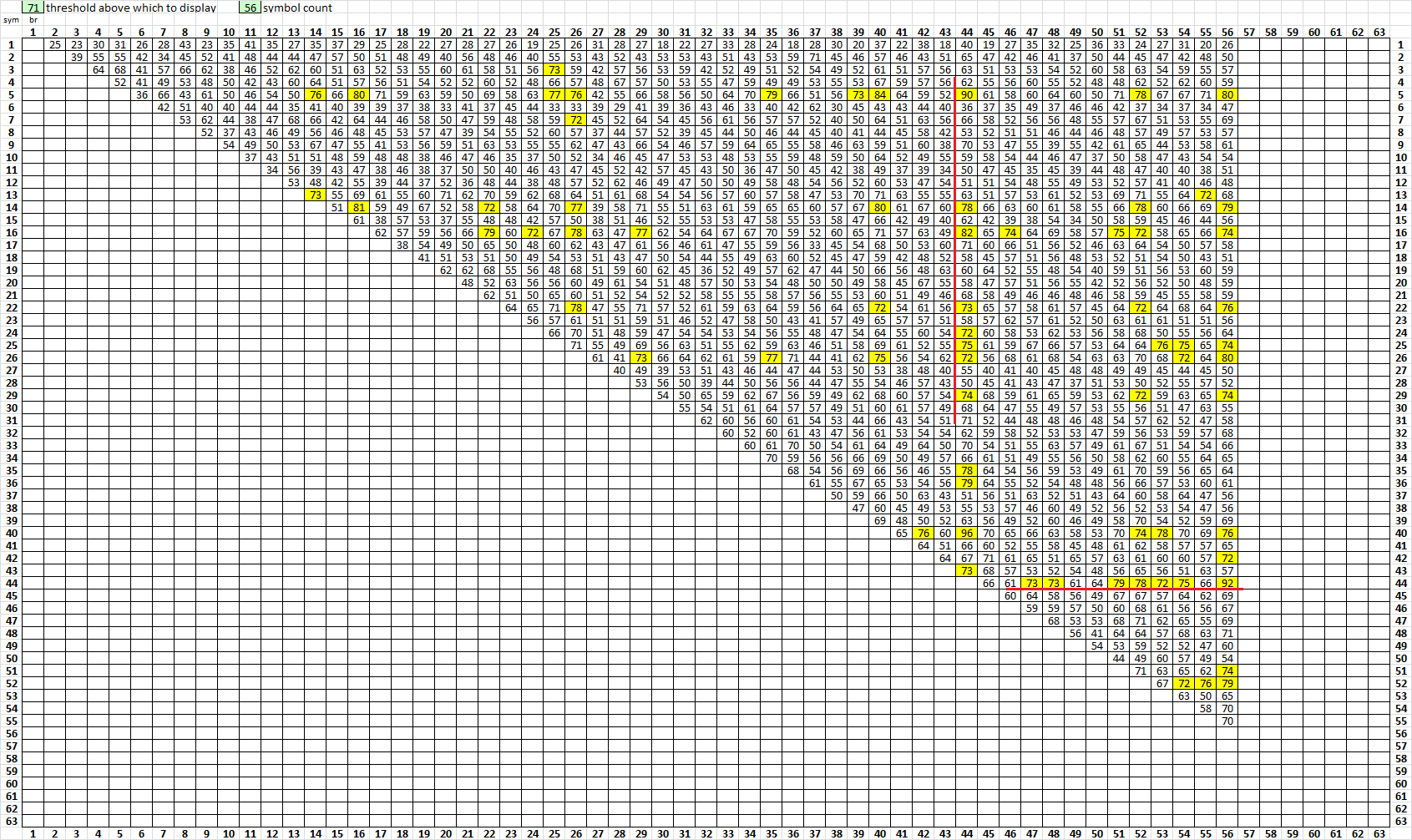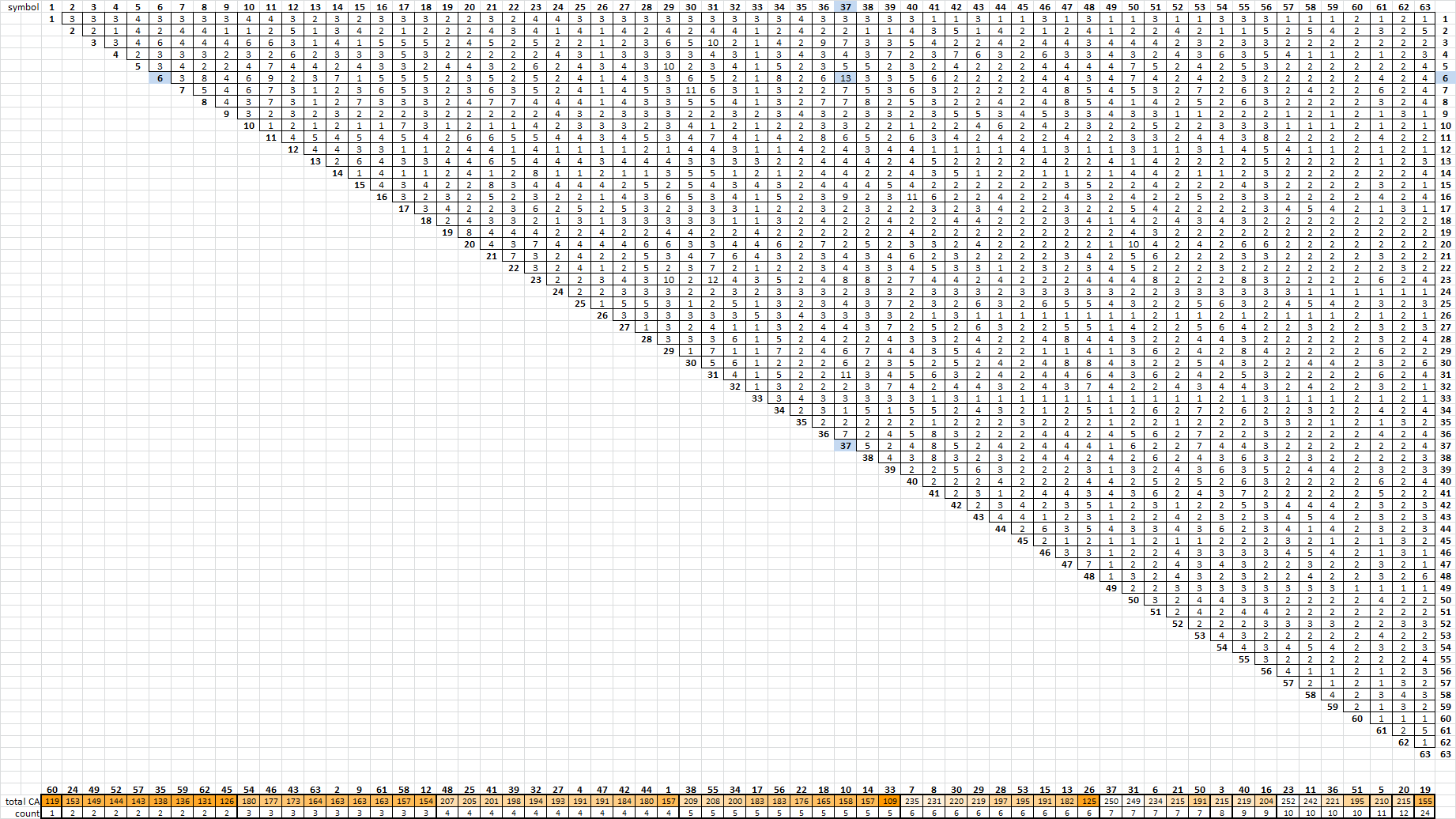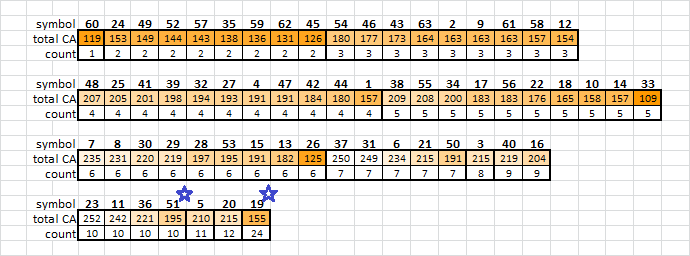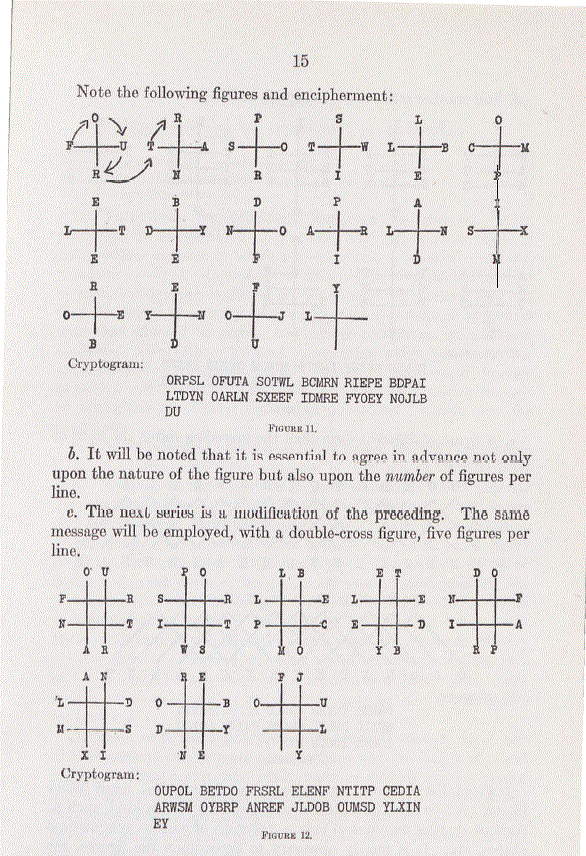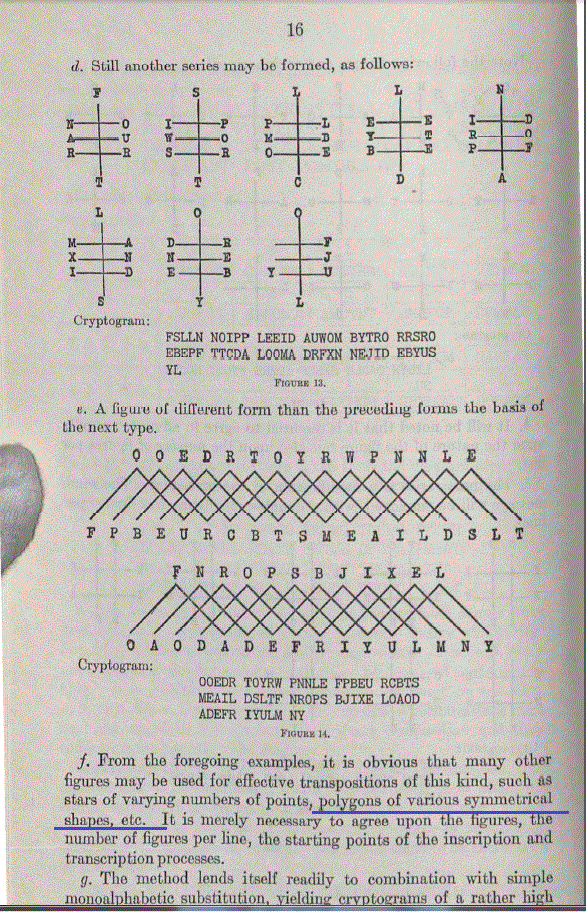Thanks for the new ciphers and examination smokie.
In my experience. When using a AZdecrypt or bigram null heatmap, one way to tell that there are probably no more nulls is that when improvements flock to the start and/or end of the cipher. Skipping or adding symbols near the start and/or the end of the cipher does not disrupt the periodical transposition as much. Perhaps it is just that.
I agree and find it more difficult to make messages with so many repeats when I put nulls closer to the middle of the message instead of at the beginning or end of the message.The distortion area is obviously smaller with nulls in the first or last row. Note that shuffle tests indicate that rows 3 and 18 could be gibberish, and some of the box corner symbols occur in rows 3 and 18. I may make a spreadsheet that detects box corners and start making messages. The box corners would have to occur in the plaintext first, then after diffusion remain. I am really wondering about the chances of the same symbol occurring in two boxes in the same message. I think that they may be Easter Eggs with the pivots.
Smokie36B has 56 symbols and 72 repeats. There are a lot of nulls, including all the same ones as smokie36A and four new ones where symbol 4 occurs in the 340.
1 2 3 4 5 6 3 7 8 9 10 11 12 13 14 15 16
17 18 19 20 21 12 9 22 23 24 25 11 10 26 27 28 29
30 31 32 33 34 35 16 36 30 37 7 29 17 7 14 1 37
38 39 40 41 13 21 7 7 42 10 21 10 43 44 7 21 35
24 45 19 46 17 47 8 41 36 48 38 7 49 42 44 22 50
2 42 7 12 11 21 3 14 18 7 51 26 39 4 9 52 14
17 47 35 34 53 2 41 26 36 45 13 11 7 2 46 53 16
30 42 22 7 13 43 8 24 3 18 28 2 53 30 6 10 47
41 37 43 5 54 3 34 45 55 7 45 5 7 3 21 27 41
5 50 13 18 14 12 31 11 9 30 44 38 34 8 35 34 18
7 32 36 50 7 45 30 17 32 23 27 27 18 10 20 33 6
42 12 16 26 7 5 2 17 34 54 15 40 14 37 11 7 16
45 36 5 32 28 10 56 9 37 3 12 38 45 51 39 7 7
8 13 14 56 37 51 56 18 50 5 30 43 35 53 26 36 50
32 31 2 42 7 11 47 51 17 9 4 41 40 45 15 7 16
14 40 24 5 47 3 36 37 22 47 13 43 14 30 2 9 11
27 16 35 8 7 42 56 27 9 5 23 26 48 30 40 29 24
6 44 29 47 15 43 16 53 7 17 32 1 48 34 14 29 8
7 51 20 25 47 47 10 37 13 7 22 38 19 5 41 56 35
4 53 22 1 36 51 44 56 45 18 10 50 27 7 16 10 15
The nulls are symbols 1, 4 and 29. However, the detection didn’t work this time for one symbol, and incorrectly identified symbol 52.
1 63
2 47
3 52
4 70
5 56
6 55
7 27
8 46
9 62
10 61
11 48
12 61
13 49
14 41
15 55
16 47
17 55
18 47
19 61
20 67
21 44
22 58
23 70
24 53
25 62
26 63
27 60
28 64
29 61
30 48
31 54
32 64
33 71
34 45
35 62
36 55
37 51
38 46
39 69
40 53
41 36
42 50
43 44
44 60
45 49
46 59
47 48
48 58
49 63
50 54
51 64
52 76
53 60
54 54
55 58
56 75
The two symbol detector didn’t work so well either, but symbol 4 did show up as a possible null when removed with symbols 51 and 56.
EDIT: The repeats went up to 78 when I removed all three nulls. It is possible to have a lot of nulls in a message that has a lot of repeats.
Smokie56C, 56 symbols and 71 repeats. Nulls are symbols 40 and 44.
1 2 3 4 5 6 7 8 9 6 10 11 5 12 1 13 14
15 16 17 1 18 1 5 19 12 20 21 22 23 3 12 24 25
1 26 27 5 13 28 29 8 4 30 31 32 33 21 1 9 6
2 34 15 35 1 36 10 37 38 18 12 39 11 28 27 33 34
4 36 40 3 25 2 41 33 42 19 14 11 38 43 44 45 27
38 15 1 6 46 41 47 6 9 28 43 48 37 37 49 13 8
48 16 4 21 50 50 38 46 11 12 42 18 23 11 1 10 37
19 10 44 25 1 32 1 13 10 26 6 28 50 1 40 51 1
45 5 52 10 20 22 48 34 27 3 31 15 21 4 53 38 25
54 27 18 27 2 3 11 50 1 47 37 8 2 28 41 11 30
9 2 42 19 42 6 45 13 6 9 55 4 21 10 1 17 1
43 36 31 1 26 44 53 30 5 19 35 40 2 50 18 28 46
25 13 52 1 3 48 1 34 38 16 26 41 17 39 55 18 26
1 12 28 11 20 6 7 8 49 1 50 31 33 1 37 28 27
3 6 19 43 24 23 36 50 19 35 19 37 30 16 28 33 56
8 5 17 9 21 40 31 48 8 1 4 44 10 38 15 51 42
11 2 12 6 15 11 13 11 19 23 1 1 20 38 37 18 13
30 16 5 38 16 9 12 35 53 34 1 5 35 32 49 50 17
45 8 1 11 6 32 8 47 27 1 46 48 41 10 17 43 6
1 32 28 42 46 20 38 12 6 23 53 41 50 31 49 43 19
Removing one symbol resulted in repeat count increases for several symbols, not just symbols 40 and 44.
1 25
2 40
3 55
4 56
5 74
6 41
7 62
8 59
9 65
10 48
11 41
12 48
13 69
14 74
15 44
16 75
17 58
18 48
19 61
20 55
21 53
22 71
23 57
24 63
25 69
26 76
27 46
28 55
29 69
30 55
31 50
32 65
33 64
34 59
35 64
36 59
37 64
38 48
39 61
40 73
41 59
42 64
43 59
44 79
45 70
46 62
47 66
48 65
49 57
50 55
51 66
52 76
53 61
54 65
55 64
56 76
Removing two symbols, symbol 44 shows up strong with a lot of other symbols.
EDIT: Look at the intersection of symbols 44 and 40 ( not marked ). When those two symbols are removed, there are 96 repeats, the highest of any two symbol combination.
EDIT 2: I tried to remove symbols 1 and 33 individually and together, and also just the box corners for the 340. Then untransposed at 90 degrees, mirrored, flipped and flipped and mirrored. It didn’t work.
340 two symbol cycle relationship quick reference table and one symbol cycle activity table
Example: Find the count of consecutive alternations between symbols 6 and 37. See shaded light blue. Find the symbols on the top row and left column, then the intersection. There are 13 consecutive alternations between symbols 6 and 37.
Example: Find the symbols that are the least cyclic for count of 4, 5 and 6 symbols. Look at the bottom of the table on the bottom row. Find the group of symbols with count of 4 in bold outline all together { symbols 48, 25, 41, 39, 32, 27, 4, 47, 42, 44 and 1 }. The symbols are sorted by count and total consecutive alternations with all other symbols, and conditional formatted so that the highest consecutive alternations will be a light color and the lowest consecutive alternations with be a dark color. For count of 4, symbol 1 has the fewest consecutive alternations at 157. For count of 5, symbol 33 has fewest consecutive alternations at 109. For count of 6, symbol 26 has fewest consecutive alternations at 125. Symbols 1 and 33 are box corner symbols, and symbols 26 and 33 are clustered together near the top and bottom of the message. But neither symbol 26 or 33 are probably polyphones because they are not distributed evenly throughout the message.
Example: Compare high count symbols 23, 11, 5 and 20 on the bottom right portion of the chart. Symbols 23 and 11 are more cyclic than symbols 5 and 20.
EDIT: Here are the total cycle scores for all of the symbols in a similar but easier to read format. Possible polyphones are symbols 51 ( F ) and 19 ( + ), which are high count but do not cycle well with other symbols.
I just found another military cryptography manual online: War Department Technical Manual TM 11-484.
http://radionerds.com/images/b/bb/TM_11-485.pdf
I just found another military cryptography manual online: War Department Technical Manual TM 11-484.
Nice! Thanks for posting this.
You’re welcome.
I have seen these figures before ( now from the book posted above ) and just skimmed over them. Now I am wondering if one of them, or a variation could create so many repeats. They are really just a variation of a route cipher with an inscription rectangle, except that the inscription and / or transcription routes sometimes involve mono literal transposition, and sometimes they involve poly literal transposition.
I will have to make some matrices and test them out. Would be pretty easy to do.
Those look like interesting possibilities. It seems to be an impossibly large effort to rule out so many possibilities! I am glad that you are helping to do so.
Zodiac liked to copy stuff, so maybe he used one of the interesting transposition schemes in one of the books.
I just added poly literal transposition to the list of issues at number 14 here: viewtopic.php?f=81&t=3196&start=330
I am better at eliminating than at solving. ![]()
Are you maintaining a list of the schemes that you believe are confidently ruled out?
That’s interesting because i recently ran a route of blocks of four, into a spiral. so it was 4×4 x5 blocks down . then back to the top and down again, it picked up the first pivot nicely which is what I was trying to do, it picked it up on the second row down. I could not get the second pivot to work in. I left the end column out.. It returned some interesting results, will have to dig it out, I have been busy busy busy.
Are you maintaining a list of the schemes that you believe are confidently ruled out?
Good question. In the last two threads, I try to make messages to match 340 stats. If I have a very difficult time doing it, then I rule it out as unlikely or highly unlikely at that point in the thread. But I don’t have a condensed list.
We have a list of route transposition issues here: viewtopic.php?f=81&t=3196&start=330
I think that Jarlve is taking a break right now. At some point we should eliminate some of the issues on the list.
Since AZdecrypt supports many transposition schemes, it would be cool if it had a "cipher generator" mode that could produce ciphers based on the current transposition matrix and other settings.
My work on the 340 and AZdecrypt transposition solver has been postponed for now.
The transposition solver needs to feedback faster in order to develop, my plan is twofold: maximize AZdecrypt speed on CPU with inline assembler and replace my 8 year old desktop with much faster hardware, probably the AMD HEDT X390 or X399 platform. When these two conditions are met work on the transposition solver can resume. I probably won’t delve into GPU for a couple of years still.
I have added support for 4, 7 and 8-grams for the next AZdecrypt WinGUI release. The 4-gram solver is double as fast as the 5-gram solver and should work very well for ciphers under 0.15 multiplicity. AZdecrypt uses allot of memory (to increase its speed) and the 8-gram solver requires 256 GB of ram. I haven’t compiled 8-grams yet and do not have the required ram by far. Perhaps it will become more feasonable with Intel Optane. Higher order ngrams are useful to solve aperiodical polyalphabetism, which is another project.
Wow, ambitious goals! I look forward to you achieving them, and hope you will be able to resume your work soon. Thank you for all of the effort you have put in so far!
Wow, ambitious goals! I look forward to you achieving them, and hope you will be able to resume your work soon. Thank you for all of the effort you have put in so far!
Thank you too doranchak, not sure if I will be able to resume soon. And smokie, sorry for leaving you in the dust a bit. I use mostly all of your of ciphers on a regular basis and I am sure that all the new transposition ciphers you have created will go a long way. I will get back on the transposition solver eventually. Has anyone heard of Largo?
I am very happy with my progress from late 2016 to early 2017:
– The release of AZdecrypt with a proper user interface and significant optimizations to the algorithm.
– Testing the 340 versus 50+ unique languages.
– Start of a decent generic (unkeyed) transposition solver.
For the 340, I am currently considering the following hypotheses:
– Transposition + substitution.
– Transposition + substitution with up to XX% polyalphabetism (the strange encoding randomness that we are seeing).
– Polyalphabetism disguised as homophonic substitution but have yet to see someone pull it off.
– No message, fake cipher.
